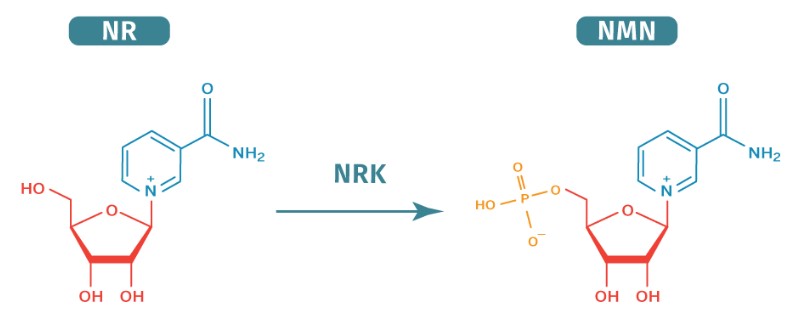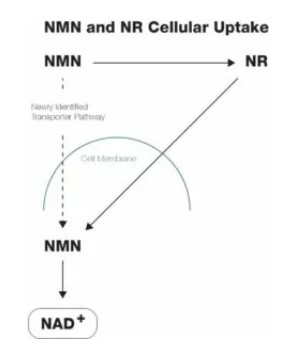Key Points
- NMN increases blood levels of the essential molecule for energy metabolism, chromosome maintenance, DNA repair, and cell stress responses – NAD+.
- Rodent studies suggest NMN improves metabolism along with cardiovascular and neurological function with age.
- NMN is generally regarded as safe with most studies utilizing 250 mg to 1 g per day doses.
NMN is an acronym for nicotinamide mononucleotide, a molecule that’s found naturally in all life forms. NMN serves as a precursor to an essential molecule for cell energy generation, DNA repair, and harmful oxygen-containing molecule (reactive oxygen species) disposal – NAD+. As such, supplementing with NMN has been found to significantly increase blood NAD+ levels in humans.
NAD+ is one of the most abundant molecules in the body. It has key roles in cellular reactions within the cell’s powerhouse – mitochondria – that produce energy molecules (adenosine triphosphate [ATP]) required for the function of all tissues in the body. Proteins called sirtuins that maintain chromosomal structure require NAD+ for their function. Other proteins called poly-ADP (ribose) polymerases (PARPs) also need NAD+ to perform their primary function – repairing DNA.
NAD+ Is Required for DNA Repair Mechanisms
As we grow older, our cells acquire DNA damage from environmental sources like pollution, radiation, and imprecise DNA replication. As such, a recent theory on how we age posits that DNA damage accumulation is a major cause of aging. Almost all of our cells contain the DNA repair machinery necessary to repair this DNA damage, and NAD+ is required for this purpose. Along those lines, the age-related decline in cellular NAD+ levels may contribute to reduced cellular capabilities to repair DNA.
Important DNA repair proteins, PARPs, depend on NAD+ for their DNA repair capabilities. As we grow older, DNA damage accumulates leading to more PARP activation. More PARP activity requires more and more NAD+, which may contribute to lower NAD+ levels in cells with age.
Sirtuin proteins, also known as “guardians of the genome,” play essential roles in maintaining our cellular health. This family of enzymes maintains chromosomal structure and participates in cell stress responses by helping to eliminate reactive oxygen species in cells. Sirtuins need NAD+ for their proper function.
As Harvard Professor David Sinclair, PhD, a leading NAD+ researcher and aging scientist, says regarding losing NAD+ as we age, “The resulting decline in sirtuin activity is thought to be a primary reason our bodies develop diseases when we are old but not when we are young.” He has proposed that naturally increasing NAD+ levels with supplements like NMN as we age may slow or even reverse some aging processes.
Increasing NAD+ Could Mitigate Age-Related Diseases
Maintaining cellular energy levels requires an adequate supply of NAD+, which tends to dissipate with age. Supplementing with NMN to restore NAD+ levels during aging has been shown to alleviate diet- and age-associated weight gain and to improve exercise capacity in aged mice. Another study showed that increasing NAD+ reversed diabetes in mice, suggesting that using NMN may be a way to restore metabolism as we grow older.
Increasing NAD+ also improves cardiovascular function in mice. In mice, increasing NAD+ levels has been shown to prevent injuries to the heart caused by reduced blood flow. This study suggests that increasing NAD+ levels during aging can preserve cardiovascular function.
Mice with Alzheimer’s display protein tangles that can lead to the inhibition of cognition. Interestingly, increasing NAD+ levels with NMN has been shown to reduce these Alzheimer’s-related proteins and improve cognition. Other studies point to increasing NAD+ in preserving neuron survival in the face of reduced brain blood flow. These findings suggest that by boosting NAD+ levels, neuron survival and cognition can be improved as we get older.
Comparing Precursors that Increase NAD+ Levels
Aside from NMN, another NAD+ precursor called nicotinamide riboside (NR) has been shown to increase blood NAD+ levels in humans. Since both of them can be used to increase NAD+, a comparison of the two molecules is useful to parse out which may be more effective.
The differences between NMN and NR relate to their molecular structures and how cells synthesize NAD+ from them. Their molecular structures are roughly the same, except that NMN has an added phosphate group, making NMN the larger of the two molecules. Since NMN is larger than NR, it likely relies on its transporter – Slc12a8 – to cross cell membranes.

Cells must convert NR to NMN via the nicotinamide riboside kinase (NRK) enzyme before synthesizing NAD+. For this reason, it appears that the most efficient precursor to boost NAD+ levels is NMN since fewer steps are needed to synthesize NAD+ from NMN.

NMN Safety and Side Effects
NMN is generally regarded as safe and without side effects. Most studies testing its safety and efficacy have used doses between 250 mg and 1 g per day in healthy adults. The longest duration of a study that measured safety to date is around 12 weeks with no adverse effects.
A clinical trial has been completed that tested the safety and efficacy of 900 mg per day NMN doses for 60 days, but the results haven’t been made public. As more data on NMN’s safety and efficacy are released, it will be interesting to find what benefits it has for humans.
Currently, data on NMN’s effects in humans reveal that it substantially increases blood NAD+ levels. Another study from Japan showed that NMN reduces blood fat (triglyceride) levels in healthy individuals. Yet another study indicates that NMN increases blood NAD+ and enhances physical function in middle-aged individuals. A study from China has shown that NMN supplementation improves sleep in middle-aged and older adults. Furthermore, a study from the Washington University School of Medicine showed that NMN increases muscle insulin sensitivity in prediabetic women. As more human data pertaining to NMN is released, the prospect that NMN increases the number of years we live without disease (healthspan) seems more likely.